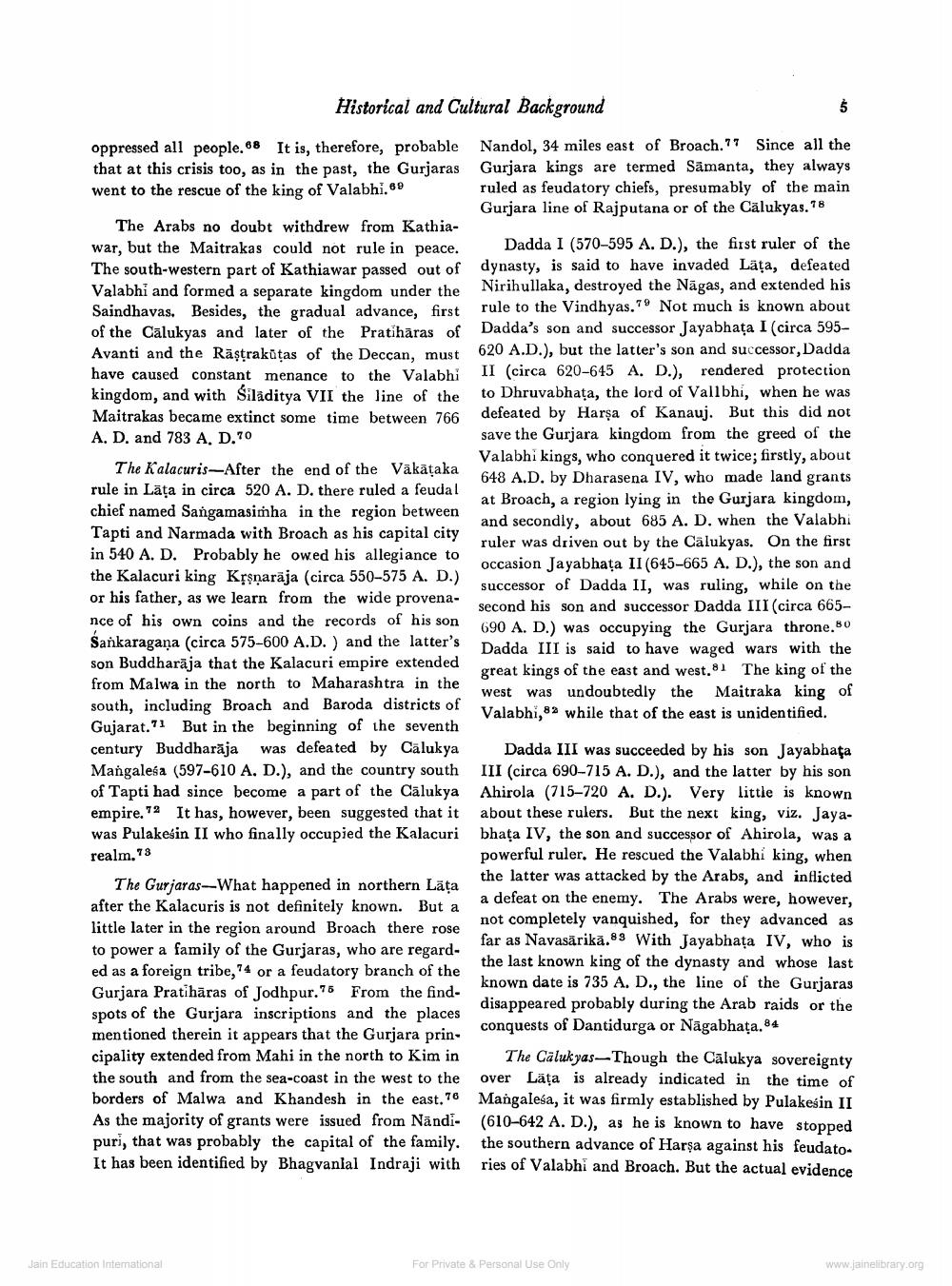________________
Historical and Cultural Background
oppressed all people. It is, therefore, probable Nandol, 34 miles east of Broach.77 Since all the that at this crisis too, as in the past, the Gurjaras Gurjara kings are termed Sämanta, they always went to the rescue of the king of Valabhi.89 ruled as feudatory chiefs, presumably of the main
Gurjara line of Rajputana or of the Cälukyas. 18 The Arabs no doubt withdrew from Kathiawar, but the Maitrakas could not rule in peace.
Dadda I (570-595 A. D.), the first ruler of the The south-western part of Kathiawar passed out of dynasty, is said to have invaded Läta, defeated Valabhi and formed a separate kingdom under the Nirihullaka, destroyed the Nāgas, and extended his Saindhavas. Besides, the gradual advance, first rule to the Vindhyas. Not much is known about of the Calukyas and later of the Pratihāras of Dadda's son and successor Jayabhata I (circa 595Avanti and the Räştrakūtas of the Deccan, must 620 A.D.), but the latter's son and successor, Dadda have caused constant menance to the Valabhi II (circa 620-645 A. D.) rendered protection kingdom, and with Siladitya VII the line of the to Dhruvabhata, the lord of Vallbhi, when he was Maitrakas became extinct some time between 766 defeated by Harsa of Kanauj. But this did not A. D. and 783 A. D.70
save the Gurjara kingdom from the greed of the
Valabhi kings, who conquered it twice; firstly, about The Kalacuris-After the end of the Vākātaka
648 A.D. by Dharasena IV, who made land grants rule in Läta in circa 520 A. D. there ruled a feudal
at Broach, a region lying in the Gurjara kingdom, chief named Sangamasimha in the region between
and secondly, about 685 A. D. when the Valabhi Tapti and Narmada with Broach as his capital city
ruler was driven out by the Calukyas. On the first in 540 A. D. Probably he owed his allegiance to
occasion Jayabhata II (645-665 A. D.), the son and the Kalacuri king Krsnarāja (circa 550-575 A. D.)
successor of Dadda II, was ruling, while on the or his father, as we learn from the wide provena
second his son and successor Dadda III (circa 665nce of his own coins and the records of his son
690 A. D.) was occupying the Gurjara throne.80 Sankaragana (circa 575-600 A.D.) and the latter's
Dadda III is said to have waged wars with the son Buddharäja that the Kalacuri empire extended
great kings of the east and west. The king of the from Malwa in the north to Maharashtra in the
west was undoubtedly the Maitraka king of south, including Broach and Baroda districts of
Valabhi,82 while that of the east is unidentified. Gujarat."! But in the beginning of the seventh century Buddharaja was defeated by Calukya Dadda III was succeeded by his son Jayabhata Mangalesa (597-610 A, D.), and the country south III (circa 690-715 A. D.), and the latter by his son of Tapti had since become a part of the Cālukya Ahirola (715-720 A. D.). Very little is known empire.T2 It has, however, been suggested that it about these rulers. But the next king, viz. Jayawas Pulakesin II who finally occupied the Kalacuri bhata IV, the son and successor of Ahirola, was a realm.73
powerful ruler. He rescued the Valabhí king, when The Gurjaras-What happened in northern Läta
the latter was attacked by the Arabs, and inflicted after the Kalacuris is not definitely known. But a
a defeat on the enemy. The Arabs were, however, little later in the region around Broach there rose
not completely vanquished, for they advanced as to power a family of the Gurjaras, who are regard
far as Navasärikā.89 With Jayabhata IV, who is
the last known king of the dynasty and whose last ed as a foreign tribe, ?4 or a feudatory branch of the
known date is 735 A. D., the line of the Gurjaras Gurjara Pratihāras of Jodhpur. From the findspots of the Gurjara inscriptions and the places
disappeared probably during the Arab raids or the mentioned therein it appears that the Gurjara prin
conquests of Dantidurga or Nagabhata.84 cipality extended from Mahi in the north to Kim in The Calukyas-Though the Calukya sovereignty the south and from the sea-coast in the west to the over Läta is already indicated in the time of borders of Malwa and Khandesh in the east. 76 Mangalesa, it was firmly established by Pulakesin II As the majority of grants were issued from Nāndi- (610-642 A. D.), as he is known to have stopped puri, that was probably the capital of the family. the southern advance of Harsa against his feudato. It has been identified by Bhagvanlal Indraji with ries of Valabhi and Broach. But the actual evidence
Jain Education International
For Private & Personal Use Only
www.jainelibrary.org




